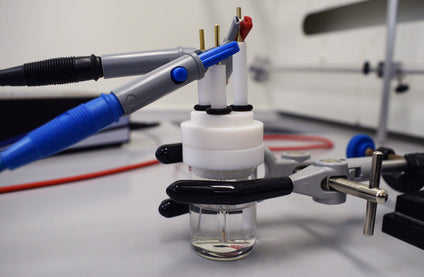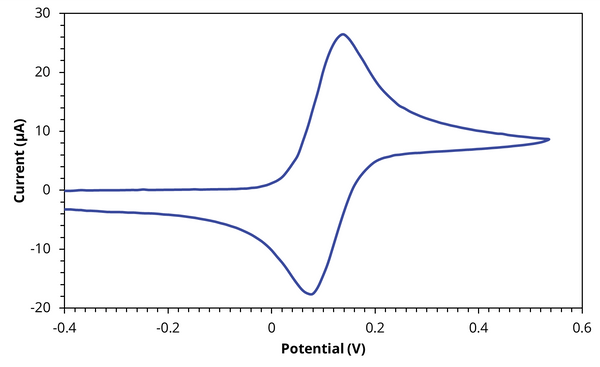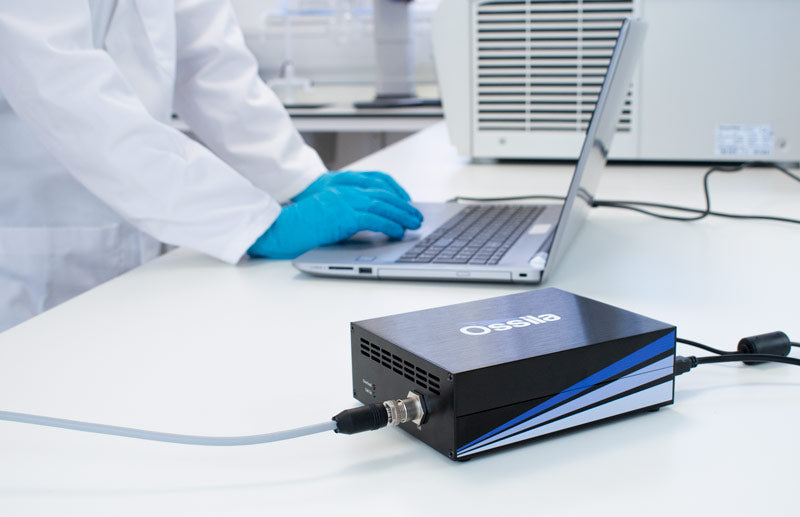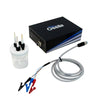Introducing the Ossila Potentiostat
Posted on Tue, Jan 14, 2020 by Chris Bracher
Potentiostats are used extensively in electrochemistry to control and measure three electrode systems. With this versatility comes a large amount of complexity, and as a result, potentiostats are often prohibitively expensive. Despite this, most people only require a fairly specific set of functions.
We have designed the new Ossila Potentiostat specifically to help electrochemists perform cyclic voltammetry without the large price tag.
The complete system is available now and includes cyclic voltammetry software, an electrochemical cell, and everything else you need to start taking measurements. With the launch of the Ossila Potentiostat also comes our new electrochemistry range, which also includes the most popular types of cells and electrodes. Large discounts are available for bundles and multi-buys.
Why Are Potentiostats Needed? The Three Electrode System

In electrochemistry, electrolyte solutions are typically studied using electrodes as interfaces.
These electrodes are named according to their use. The electrode where measurements are taken is known as the working electrode; the electrode that completes the circuit and allows current to flow is known as the counter electrode; and the electrode that provides a reference potential is appropriately called the reference electrode.
In a two-electrode system, one electrode acts as both the reference and counter electrode. In this arrangement, it is difficult (or impossible) to control the potential while the measurement is being taken. While this is useful for certain applications, like measuring the efficiency of a battery, its applications for electrochemistry are limited.
Acknowledging electrode potential to be “the dominating factor governing many electrolytic processes” while also identifying the difficulties with two electrode systems, the first three electrode system with a separate reference and counter electrode was designed by Hickling in 1942 [1].
In his paper, Hickling described the advantages of an experimental setup where “the potential of a working electrode can be fixed at any desired arbitrary value”. This, Hickling said, “would seem [...] to have many valuable applications in the exploration of electrolytic processes”.
In order to achieve this, Hickling designed the first three-electrode potentiostat. Since then, the devices have been the central piece of equipment in electrochemistry labs across the world. Without the potentiostat, there would be no three-electrode system, and most electrochemical studies would either not be possible at all or would be fraught with inaccuracies and errors.
What Does a Potentiostat Do?
Potentiostats are now the cornerstone of the electrochemistry field.
Like Source Measure Units (SMUs), potentiostats are control and measurement devices. The potential between the working and reference probes is controlled, and the current between the working and counter probes is measured.
In cyclic voltammetry, one of the most commonly performed electrochemical methods, the potential is increased linearly until a determined maximum is reached. It is then withdrawn and cycled in this way as the current is measured to form a characteristic ‘duck-shaped’ plot.

From this plot, you can determine a number of electrochemical properties.
Introducing The Ossila Potentiostat

One of the major drawbacks of potentiostats is their price. This is particularly problematic for teaching labs where multiple units are required, but it is also a significant barrier to entry for any researcher looking to take any electrochemical measurements. In addition to the considerable cost associated with the purchase of the unit itself, many potentiostats on the market either require computational knowledge or dedicated software that needs to be purchased separately.
The Ossila Potentiostat has been developed as a powerful but low-price device for performing cyclic voltammetry. The required software is included at no additional cost.
Working, counter, and reference electrodes as well as glassware are also provided (though the potentiostat can be purchased without these if they are not required). Therefore, it is possible to set up a three-electrode system and start taking electrochemical measurements very quickly.
Potentiostat with Cell and Electrodes

- Affordable
- Easy to Use
- Worldwide Shipping
Buy Online £1,900.00
The Ossila Potentiostat for cyclic voltammetry is now available to buy online. Please contact us if you have any questions.
References
- Studies in electrode polarisation. Part IV.-The automatic control of the potential of a working electrode, Hickling, A. (1942); doi:10.1039/TF9423800027.
Author: Chris Bracher
Chris joined Ossila in 2016 after completing a PhD in polymer and perovskite solar cells at the University of Sheffield. During his PhD, he gained expertise in photovoltaic device fabrication and characterisation, thin-film solution processing, and the construction of automated testing systems. Formerly part of the OFET and 2D materials teams at Ossila, he now focuses on the development of new test and measurement systems, with an emphasis on software.